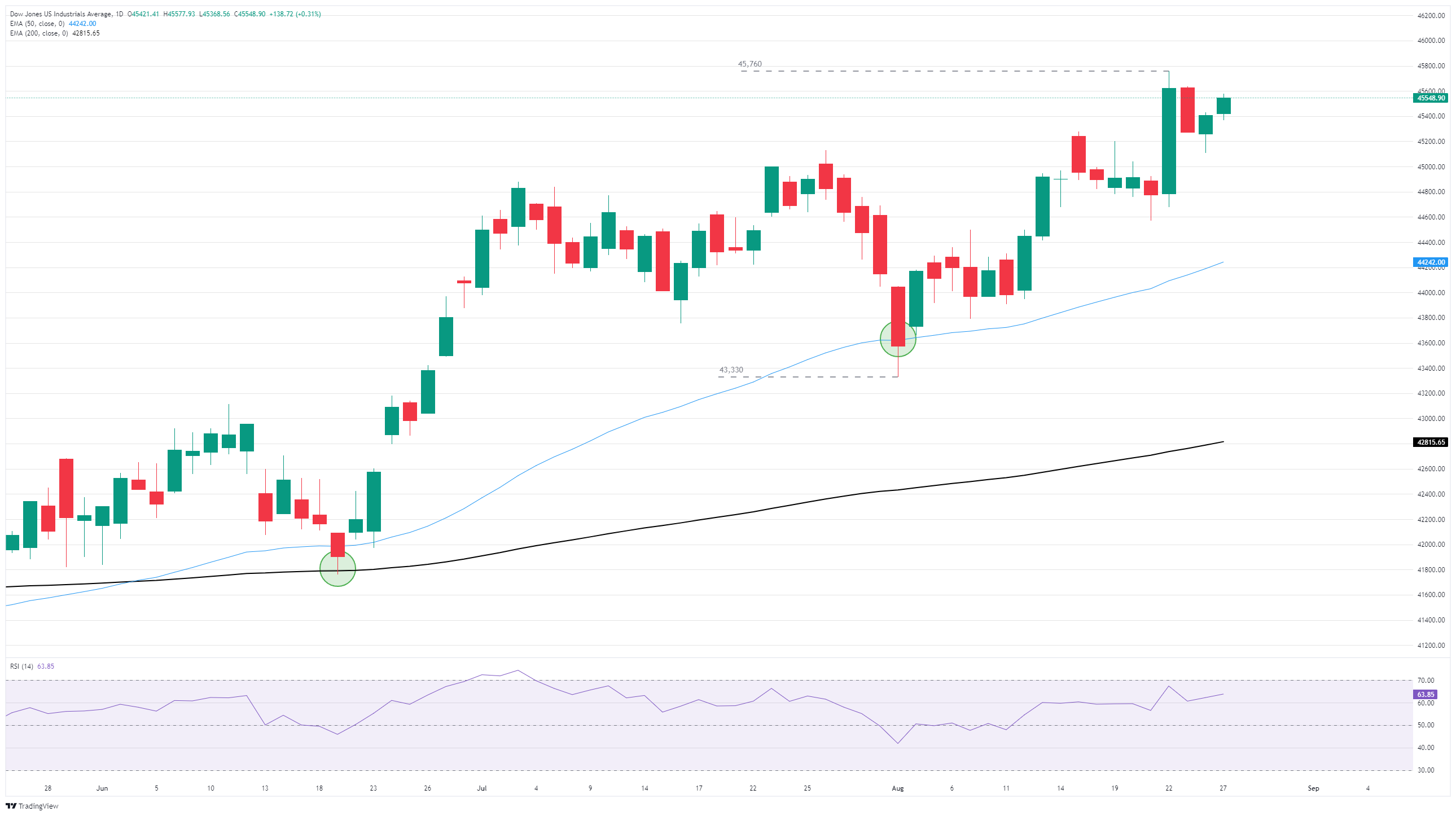Dow Jones Industrial Average resumes upwards equity grind
- The Dow Jones gained ground on Wednesday as equities broadly push higher.
- Markets are finding their bidding buttons amid a lack of game-changing news.
- US GDP growth, PCE inflation data due through the latter part of the week.
The Dow Jones Industrial Average (DJIA) drifted upwards on Wednesday as global equities grind their way higher heading through the midweek lull. Investors are shrugging off United States (US) President Donald Trump’s attempts to dump and replace voting members of the Federal Reserve (Fed), and markets are betting that this week’s upcoming Gross Domestic Product (GDP) and Personal Consumption Expenditures Price Index (PCE) inflation updates won’t break the bank on bets that the Fed will deliver a quarter-point interest rate cut in September.
The Dow Jones is backfilling a technical decline that dragged the index off of record highs late last week, grinding back above the 45,500 level after finding a support floor near 45,200. The Dow is still a touch off its all-time peaks at 45,760, but the index’s long-term bullish tilt remains firmly intact.
US President Donald Trump is working on replacing Federal Reserve (Fed) Board of Governors members with his own picks who will, in theory, be more friendly to his desires for rapid interest rate cuts. Markets are largely brushing off the direct challenge to the Fed’s political autonomy, but a continued escalation in Fed policymaker headlines could chip away at investor sentiment moving forward.
PCE inflation, Nvidia earnings cast shadows over the midweek market
Q2 GDP growth figures are due on Thursday. Quarterly growth is expected to tick up to 3.1% on an annualized basis. The data docket is saving the best for last this week, with PCE inflation figures slated for Friday. Inflation remains a looming threat to the trajectory of Fed rate cuts, and could hammer back September rate cut hopes if it accelerates too fast, too quickly between now and September 17. July’s core PCE inflation is expected to rise to 2.9% YoY.
AI tech rally darling Nvidia (NVDA) will be releasing its latest quarterly earnings report after the closing bell on Wednesday. Nvidia has been the main driving force behind the AI-fueled bull run that has absorbed the lion’s share of equity moves recently. The chipmaker has grown so large that it now accounts for 8% of the entire Standard & Poor's 500 (SP500) index all by itself. Nvidia has outperformed analyst expectations for 11 of the last 12 straight earnings quarters, but still delivered a poor post-earnings performance for four of them.
Dow Jones daily chart

Dow Jones FAQs
The Dow Jones Industrial Average, one of the oldest stock market indices in the world, is compiled of the 30 most traded stocks in the US. The index is price-weighted rather than weighted by capitalization. It is calculated by summing the prices of the constituent stocks and dividing them by a factor, currently 0.152. The index was founded by Charles Dow, who also founded the Wall Street Journal. In later years it has been criticized for not being broadly representative enough because it only tracks 30 conglomerates, unlike broader indices such as the S&P 500.
Many different factors drive the Dow Jones Industrial Average (DJIA). The aggregate performance of the component companies revealed in quarterly company earnings reports is the main one. US and global macroeconomic data also contributes as it impacts on investor sentiment. The level of interest rates, set by the Federal Reserve (Fed), also influences the DJIA as it affects the cost of credit, on which many corporations are heavily reliant. Therefore, inflation can be a major driver as well as other metrics which impact the Fed decisions.
Dow Theory is a method for identifying the primary trend of the stock market developed by Charles Dow. A key step is to compare the direction of the Dow Jones Industrial Average (DJIA) and the Dow Jones Transportation Average (DJTA) and only follow trends where both are moving in the same direction. Volume is a confirmatory criteria. The theory uses elements of peak and trough analysis. Dow’s theory posits three trend phases: accumulation, when smart money starts buying or selling; public participation, when the wider public joins in; and distribution, when the smart money exits.
There are a number of ways to trade the DJIA. One is to use ETFs which allow investors to trade the DJIA as a single security, rather than having to buy shares in all 30 constituent companies. A leading example is the SPDR Dow Jones Industrial Average ETF (DIA). DJIA futures contracts enable traders to speculate on the future value of the index and Options provide the right, but not the obligation, to buy or sell the index at a predetermined price in the future. Mutual funds enable investors to buy a share of a diversified portfolio of DJIA stocks thus providing exposure to the overall index.

